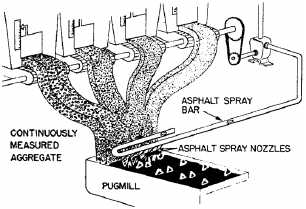Discharge Gate
Little time is lost in discharging a
completed batch through the hydraulically
actuated discharge gate because there is
no
segregation
of
materials.
The
gate
opens
across
the
entire
length
of
the
paddle
shafts
and
across
the
width
(distance
between
the
paddle
shaft
centers) of the pugmill. Being relatively
large,
the
gate
opening
permits
access
from
the
bottom
for
maintenance
and
replacement of parts.
Plant Automation
The batch asphalt plant is almost
completely
automated.
After
mix
proportions and timers are set and the
plant is started, the plant repeats the
weighing and mixing cycles until stopped
by the operator or until a shortage of
material
or
some
unexpected
malfunction
causes the plant to shut down itself.
The plant operator’s manual provided
by the manufacturer, provides details on
the setup and adjustment of the automatic
equipment. You must check the accuracy and
adjustment of this equipment, particularly
the
aggregate
scales,
asphalt
scales
or
meters,
batching
controls,
and
recording
equipment (if used). This should result in
trouble-free
production;
moreover,
the
entire
plant
should
be
checked
periodically
to
ensure
the
finished
product
meets
specifications.
CONTINUOUS-FLOW ASPHALT PLANT
The continuous-flow asphalt plant is
shown
in
figure
8-2.
Continuous-flow
asphalt plants are equipped with positive
displacement asphalt pumps. One type is
regulated by changing the drive sprockets
or gears that are mechanically interlocked
with
the
aggregate
feeders
(fig.
8-16).
The other is controlled by a calibrated
remote control handwheel on the mixer
operator platform. When using the former
type,
you
must
use
the
manufacturer’s
tables as a basis for determining the
proper pump and sprocket combinations to
fix the amount of asphalt discharge. By
doing so, you can control the feeder gates
and asphalt pump while ensuring no change
in
setting
can
be
made
without
the
knowledge of the asphalt plant supervisor.
The temperature of the asphalt going
through the positive displacement asphalt
pump must be known at all times to
maintain
constant
asphalt
proportioning.
You should take frequent readings of the
thermometer
installed
in
the
circulating
line just ahead of the pump. This allows
you to make any necessary adjustments to
Figure 8-16.-Spray-bar operation with asphalt
distribution mechanically interlock with
aggregate feeders.
compensate
for
volume
changes
in
the
asphalt
when
substantial
temperature
changes occur.
Pugmill Mixer
The
function
of
a
continuous-flow
plant pugmill is almost identical to the
pugmill
in
the
batch
mix
plant.
The
primary
difference
is
that
the
mixing
principle is different. In a batch mixer,
the materials are confined in the mixing
chamber.
In
a
continuous-flow
plant
pugmill mixer, the materials are propelled
toward the discharge. The mixing pressure
varies
with
the
height
or
weight
of
material
in
the
pugmill
that
can
be
controlled by adjusting the dam gate at
the discharge. The height of material in
the pugmill mixer should not be allowed to
rise
above
the
paddle
tips,
with
the
exception of the last set of paddles.
To improve the mixing efficiency of
the pugmill, you should make the following
adjustments:
1. Raise the dam on the discharge
end of the mixer to hold the
material in the mixing unit for a
longer period of time at a depth
that
will
further
intensify
the
mixing
action.
2. Adjust or reverse the pitch of
the paddles to retard movement of
the material through the pugmill
and increase the degree of mixing
action within the unit.
Nonuniform mixing can occur if the
mixer is overfilled. At maximum operating
efficiency,
the
paddle
tips
should
be
barely visible in the material at the top
of the arc during mixing. The batch rating
of
the
pugmill
for
the
continuous-flow
plant is the same as for the batch plant.
8-15

